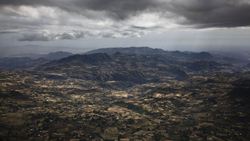In Ethiopia, foreign investment is a fancy word for stealing land
By Daniel Medina
It’s been called by some to be a new form of colonialism. Others say it is outright theft.
Since 2000, over 37 million hectares of land, mainly in the world’s poorest nations, have been acquired by foreign investors “without the free, prior, and informed consent of communities” in what, according to Oxfam and other organizations, constitutes a “land grab.” It’s a portion of land twice the size of Germany, according to researchers.
More than 60% of crops grown on land bought by foreign investors in developing countries are intended for export, instead of for feeding local communities. Worse still, two-thirds of these agricultural land deals are in countries with serious hunger problems. A report by the University of Virginia in collaboration with the Polytechnic University of Milan says that a third to a fourth (pdf, p. 1) of the global malnourished population, or 300 to 550 million people, could be fed from the global share of land grabs.
Instead, the land is used to grow profitable crops—like sugarcane, palm oil, and soy. The benefits of this food production “go to the investors and to the countries that are receiving the exports, and not to the benefit of local communities,” says Paolo D’Odorico, professor of environmental sciences at the University of Virginia. He attributes the phenomenon to a global “commodification of land” and says the problem will only get worse in the coming years as food prices continue to rise globally.
Land grabs in the developing world create a system so unequal that resource-rich countries become resource dependent.
In Ethiopia, one of the world’s largest recipients of foreign aid, the problem is particularly acute. In a country where over 30% of the population (pdf) is below the food poverty line, crops are exported abroad—primarily to India, Saudi Arabia and the Gulf Cooperation Council (GCC) states.
Multinationals buy up the land from the Ethiopian government for lease and bring in workers to farm it.
Favorable climate conditions and government relief have led Ethiopia to be chosen as a new production site by many flower growers present in Kenya. Bangalore-based Karuturi Global, the world’s largest rose exporter, has rose plantations in the country, and is planning the development of a 300,000-hectare lease in the Gambella area.
Alfredo Bini, an Italian photojournalist, examined Ethiopian land grabs in his recently released photo series, “Land Grabbing.” For the investors, Bini explains, the deals were not “land grabs” but opportunities to get huge returns on investments.
As Birinder Singh, the executive director of Karuturi in Ethiopia, plainly states in his interview with Bini: “When someone calls it ‘land grab,’ we call it ‘land development.'”
“These companies—mostly Saudi and Indian—are signing deals with the Ethiopian government to lease this land… for 25, 30, sometimes 50 years, depriving local populations of the ability to harvest their crops and feed themselves,” Bini told Quartz. “The government says the lands are empty and not being harvested but from what I saw and documented in my reporting this is entirely not the case.”




















